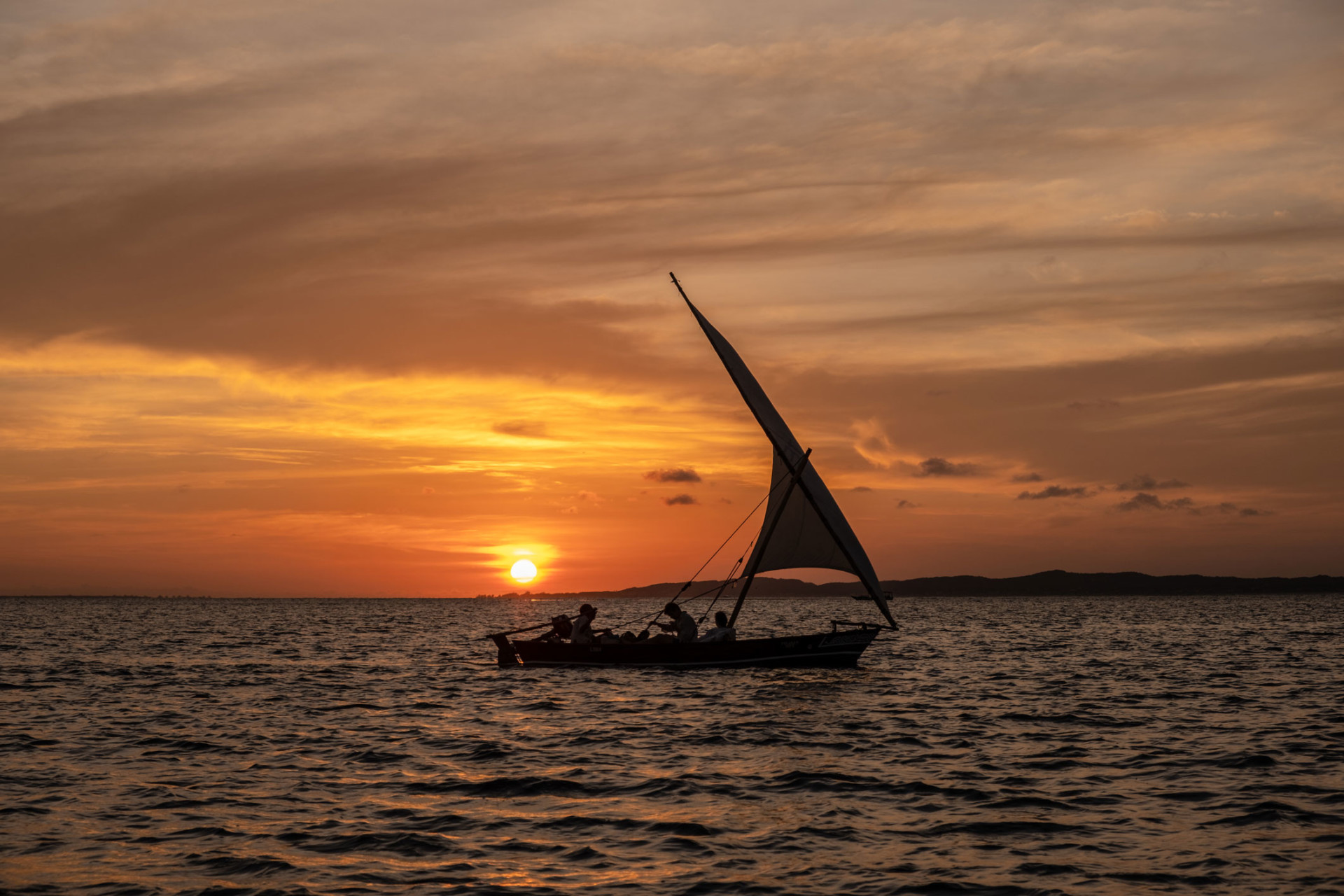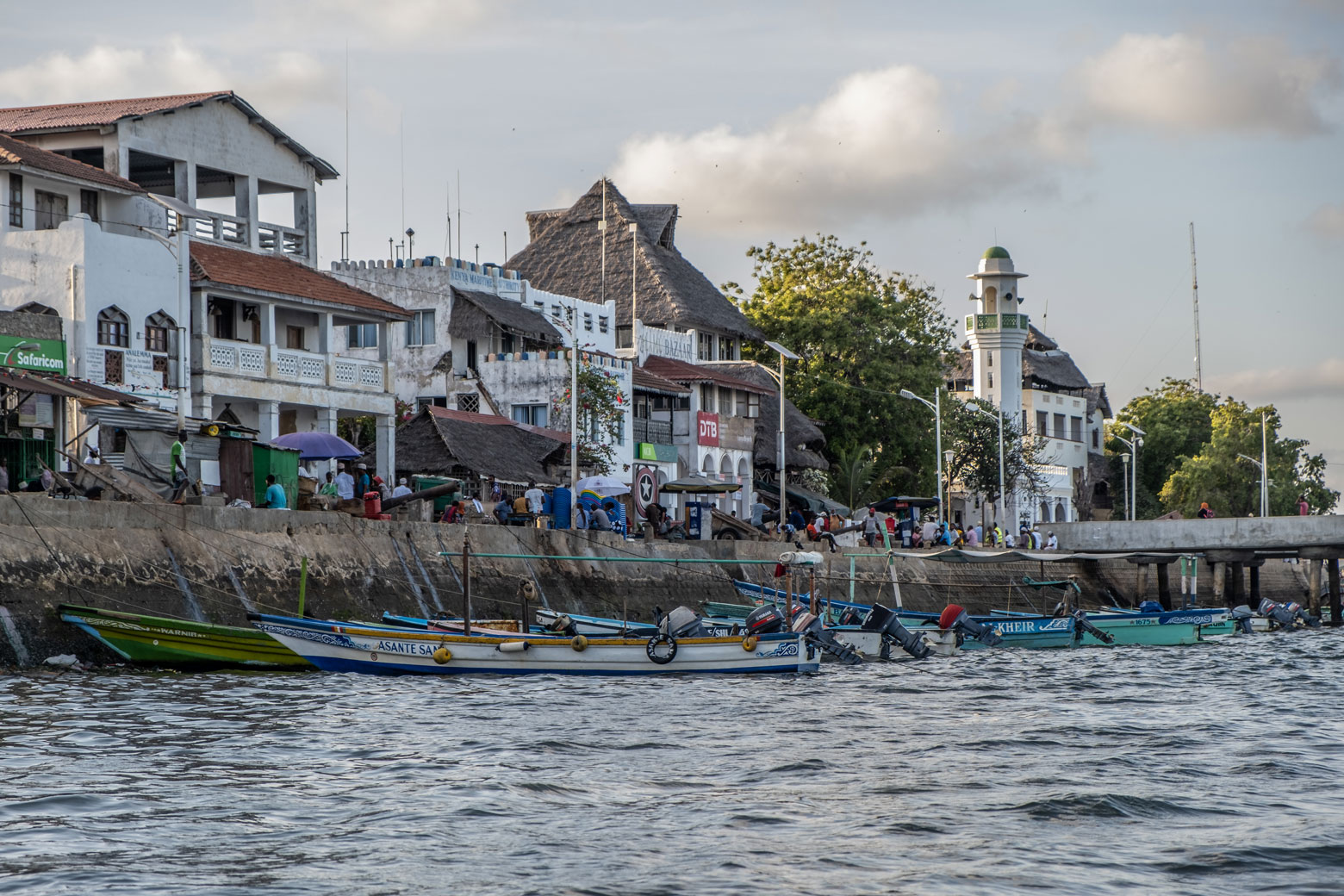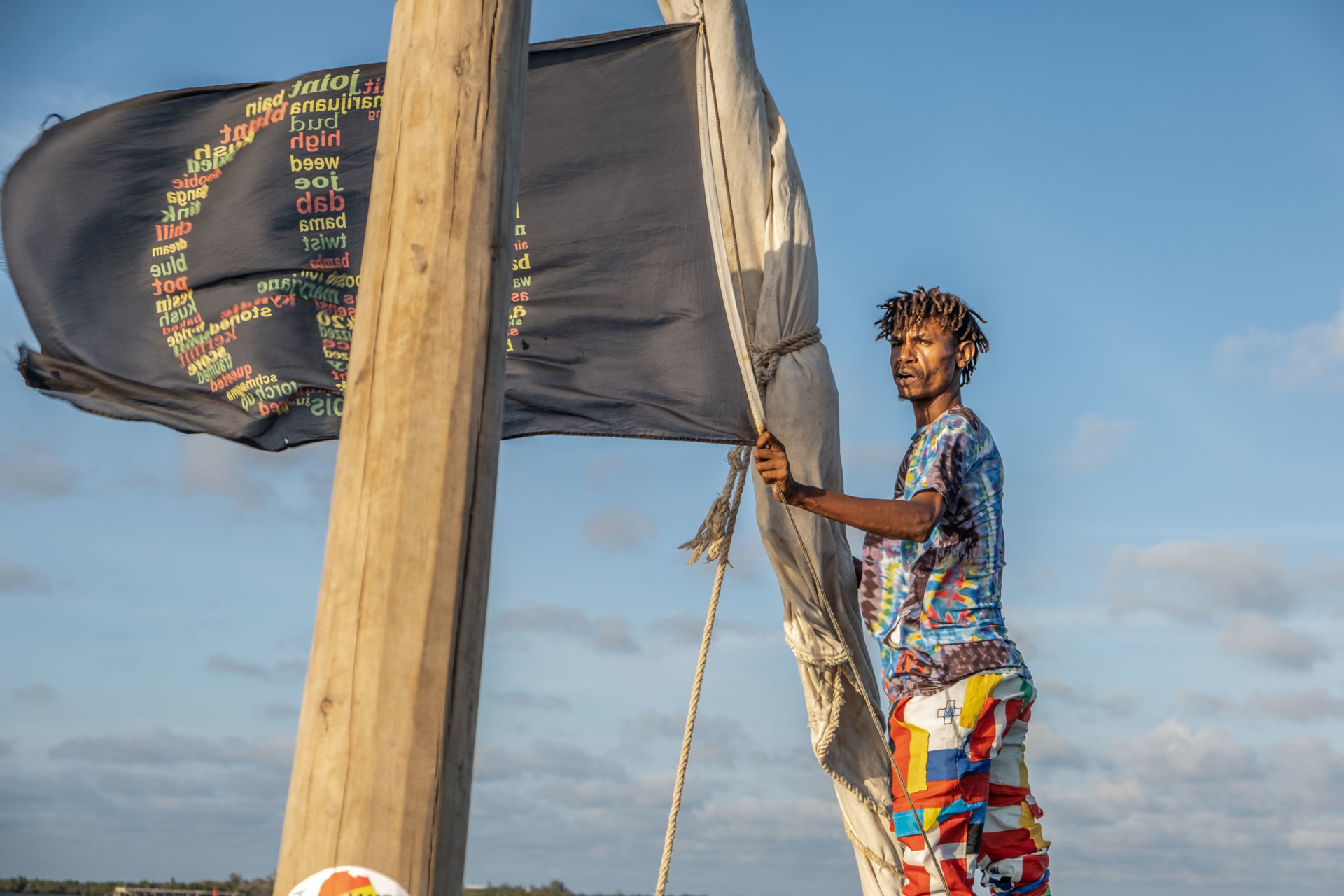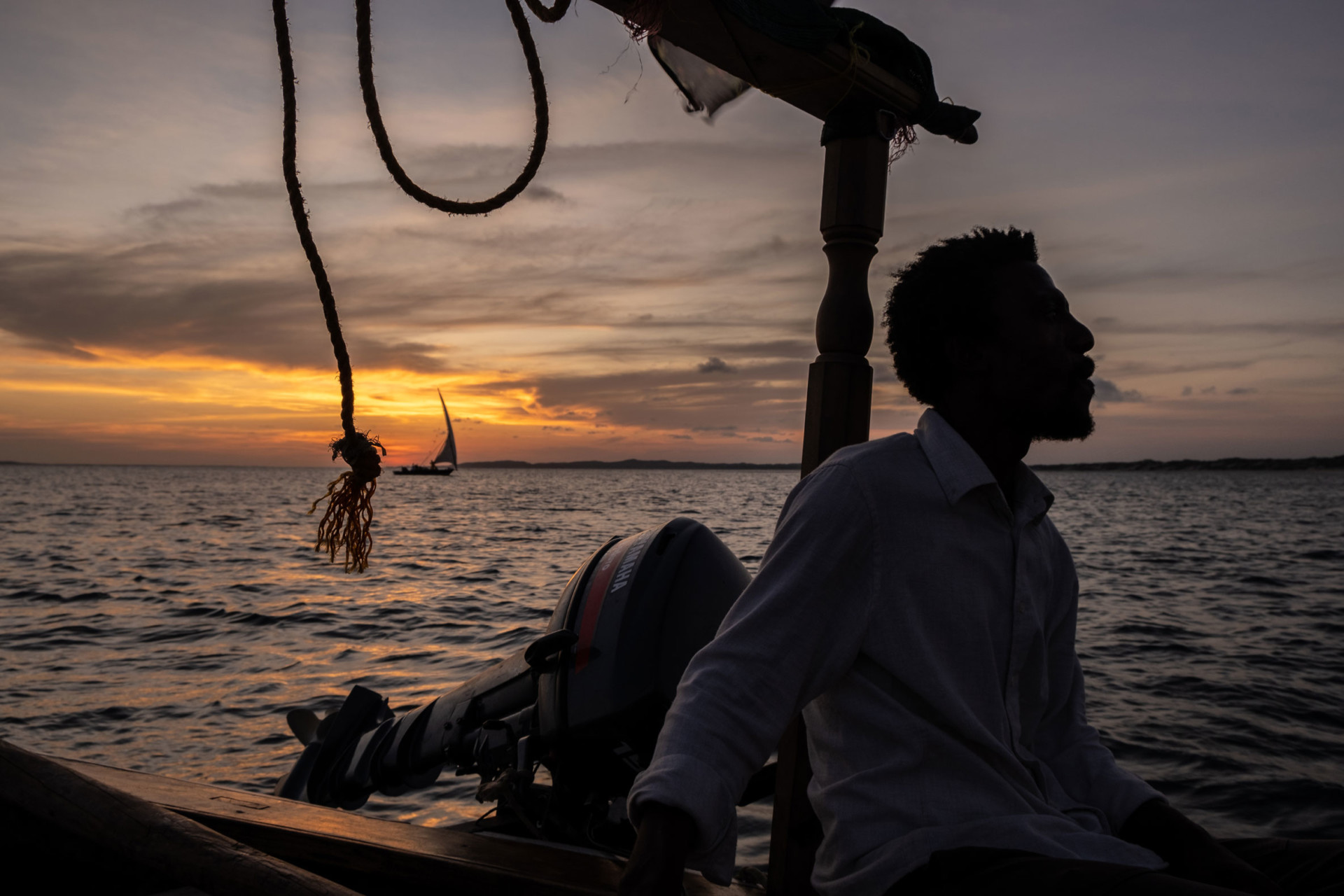A group of fishermen raise the sail of a “dhow,” a traditional sailing vessel, allowing it to quietly glide across the Indian Ocean. Glittering stars dot the clear night sky as the wind gently guides us back to Lamu Island, located on Kenya’s northern coast, which borders Somalia. In the distance, reddish lights protrude from the horizon and meet the black sky.
“It looks like hell is coming,” says Mbarak Athman, a 35-year-old fisherman, shaking his head in irritation as he faces the glaring lights emanating in the distance from the grounds of the Chinese-built Lamu Port South Sudan-Ethiopia Transport (LAPSSET) Corridor, a $25 billion infrastructure project set to link Lamu port to South Sudan and Ethiopia. It is the single largest infrastructure undertaking in the eastern Africa region, which the government officially opened last year and expects to complete in 2030.
Several fishermen sit comfortably on the dhow chewing “miraa,” or “khat,” a plant used as a stimulant in the Middle East and Africa. “Our government just really wants us to join al-Shabab,” another fisherman interjects, frustrated and peeling the sides of the miraa stem, mixing it with gum nestled in his cheeks. “It doesn’t make sense how they can just leave us here with nothing.”
In reality, these fishermen have no intention of joining al-Shabab, a Somalia-based Islamic insurgency group that has carried out several deadly attacks in Kenya over the years. But they are expressing deepening frustrations over their perceived exclusion from the future of Lamu and the development promised through LAPSETT’s construction.
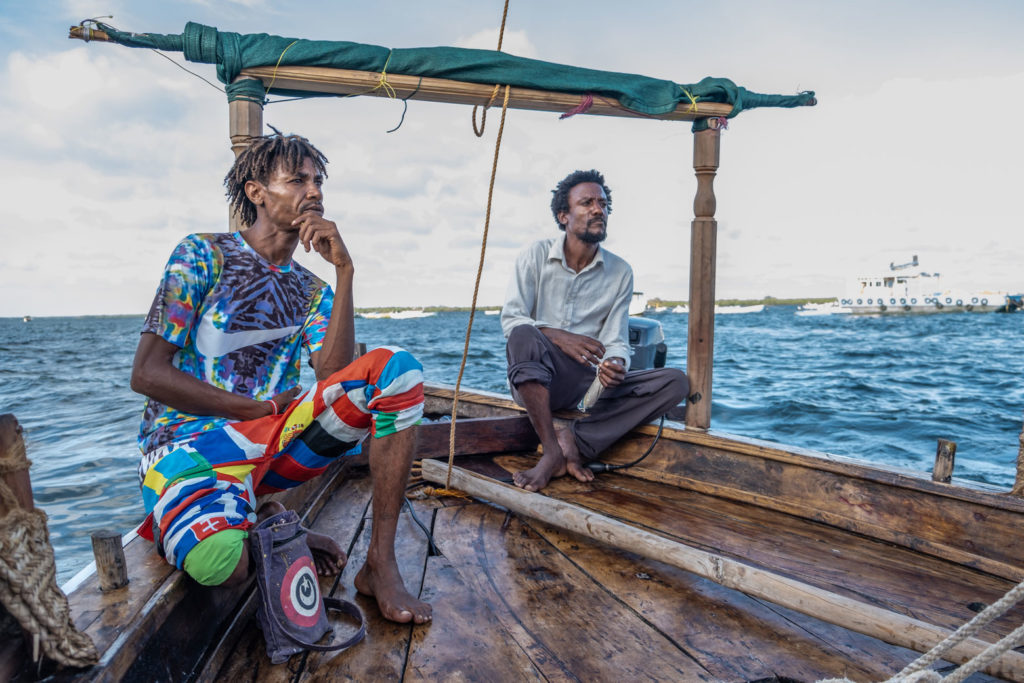
Expecting jobs and economic benefits, these fishermen’s lives were instead thrown into disarray. Fishing has been the main economic source of sustainability in Lamu for hundreds of years, perpetuated through generations of family fishermen. But as the Kenyan government aims to develop the northern coast, it is becoming clear to the fishermen that there is no space for them in this new vision of Lamu.
“This government has forgotten us,” Athman says, peering out into the vast oceans around him. “We go months now just sitting around doing nothing and with nowhere to go. They destroyed our lives with this port and then they don’t even give us jobs there. I don’t know what they expect us to do.”
A group of tourists from the capital, Nairobi, saunter past a line of young men on the seaside of Lamu’s Old Town, the oldest Swahili settlement in East Africa and a UNESCO World Heritage Site located on one of the county’s 65 islands. It is a place where time seems to stand still, with quaint, old homes built with coral stone and mangrove timber; donkeys, the only permitted transportation in town, trot down its narrow alleyways.
“Where are you from?” the men shout at the Nairobi tourists.
“The same country you are from,” one of them answers.
“And which country is that?”
The tourist stops and looks at the men, confused. “Uh, Kenya,” she responds.
The men break into laughter. “No, no. You are from Kenya. We are from Paradise,” one of them quips. While this was a lighthearted attempt to get under these tourists’ skin, it reveals the sentiments of some residents in Kenya’s coastal region, which has long been neglected by the central government in Nairobi, nearly 300 miles away. The largest ethnicity in Lamu has historically been the Bajuni — almost all of whom are Muslim.
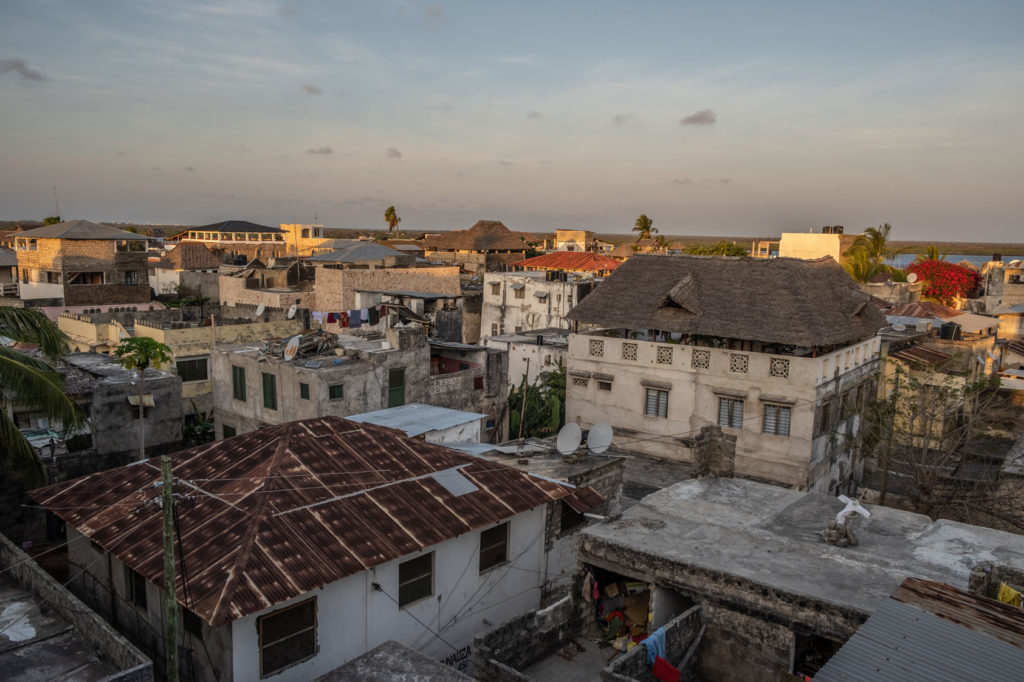
During the 19th century, Lamu was a thriving religious center and port city based on trade and slave-run plantation agriculture, with links to a wider Omani-led, Indian Ocean trading network. According to Ngala Chome, a Kenyan academic specializing in post-colonial Mombasa and coastal politics, the imposition of British colonial rule and the subsequent abolishment of slavery in 1907 undermined Lamu’s political and economic influence.
Unlike other parts of the coast, where the sultan of Zanzibar exercised control and which remained a protectorate under the sultan during British rule — known as the 10-mile coastal strip — Lamu was fully consumed into the British colony.
“That land in Lamu was deemed [British] government land,” Chome tells me. “In 1963, when Kenya got its independence that has continued to be the case,” with land formerly owned by the British government being transferred to the independent Kenyan government. Throughout the decades, Lamu has been “filled with landless people,” he says, who do not have legal ownership over the land they live on.
The few individuals in Lamu who owned land were white settlers who had stayed behind after independence or the new African elites, particularly those of Kikuyu ethnicity, who could acquire land through their ties to the Kikuyu-dominated independent government.
In the 1970s, Jomo Kenyatta, Kenya’s first president, established the Lake Kenyatta Settlement Scheme, providing 12-to-15-acre plots for individuals and families in Lamu. Mpeketoni, now a Kikuyu majority town on mainland Lamu and the site of an al-Shabab attack in 2014, grew out of this settlement scheme. Several other schemes were instituted over the next few decades. While some Bajuni families on the islands benefited from these, the overwhelming majority of the beneficiaries, about 90%, were Kikuyu from central Kenya.
Fishing, meanwhile, is one of the most important economic sectors in Lamu, sustaining the livelihoods of at least 75% of residents, either directly or indirectly. Yet it has never received any form of government support, Chome explains.
“There are a lot of problems associated with that and the informality of the trade,” he tells me. “They are not really allowed to export fish. There’s no market because the government hasn’t established any. In Lamu, fishermen sell their fish on the rocks by the seaside because there’s no market and no formal chains.”
Even tourism, which also makes up an important part of Lamu’s economy, is solely driven by private business and has never been buttressed by national state policy. These historical factors have all influenced the ways in which the Bajuni people in Lamu view their relationship to the Kenyan state. Newcomers from interior parts of Kenya buying or being offered land in a region where most of the locals are landless agitates feelings of marginalization.
Muslims in the coastal region have also long complained about being treated as outsiders in Kenya’s formal system, which includes humiliating vetting processes to obtain national identification cards for Kenyans with Arabic names, often accusing them of being foreigners. To this day, there are some Muslim elders who still cannot get national identification cards. Others were forced to adopt Kikuyu last names.
Many Bajuni people in Lamu remain illiterate, unemployment is high and few have access to electricity or running water in their homes. “They [the Kenyan government] think that Lamu is just the end of Somalia,” Athman says, his dreadlocks falling over his face. “So they don’t care. They have never paid attention to us.”
Despite this, life was relatively peaceful for the fishermen on Lamu Island.
“We have four generations of fishermen in my family,” says Athman, who learned fishing and dhow-sailing from his father. “I started when I was 10 years old, going out with my papa to the sea.” Many fishermen on the island supplemented their income by taking tourists out on the traditional dhow for sunset cruises and snorkeling. Sea turtles were plentiful in Lamu’s marine reserves and were a top tourism attraction.
The fishermen could easily afford their children’s school bursaries, and they were well known on the island to be “good spenders,” quickly using up their earnings for the day, knowing that the following day more would come. But life has since dramatically changed.
LAPSETT is expected to include more than just a modern port. According to Chome, it also consists of new transport infrastructure, including an airport, a series of highways, a railway and an oil pipeline. There are also plans to construct an oil refinery, special economic zones, and a new metropolis city with the capacity to accommodate 1.1 million people. Today, Lamu’s population is approximately 145,000.
“The central government elites felt comfortable launching such a project and laying claim to thousands of hectares of land … because the land belonged to the government,” Chome explains. “They didn’t have to buy any of the land. But in Lamu this same land is where people built houses, where people have farmed, and buried their relatives over the years.”
Owing to high levels of corruption, it is common in Kenya for wealthy individuals to acquire private titles for land belonging to the government. Predictably, this is exactly what happened in Lamu. Starting around 2010, companies acquired private titles to hundreds of thousands of acres of public land around the area of the planned port, Chome says, subdividing it and advertising “cheap land for sale” on social media and WhatsApp.
This created a “frenzy of land buying” from 2011 to about 2013. According to Chome, some of the land was being sold for as cheap as 10,000 Kenyan shillings ($86) an acre; most of it went to buyers from Nairobi. Despite the participation of a few Bajuni families in this process, the scenes were a repetition of the historically rigged development in Lamu, in which Kenyans from the interior, mostly Kikuyu, benefited from government projects, while the Bajuni were largely ignored.
For the Bajuni fishermen, the more attention the government paid to Lamu, the more they saw their lives turned upside down.
In October 2011, after al-Shabab launched a series of grenade attacks and kidnappings targeting tourists near Lamu, the Kenyan military launched Operation Linda Nchi, Swahili for protect the nation, along Lamu’s border with Somalia, in an effort to prevent the militants from entering the country.
Tourism plummeted and the Kenyan military restricted the fishermen’s movements because of alleged security concerns, enforcing a nighttime curfew in Lamu for nearly a decade, which prohibited night fishing. Before this operation, a crew of about 20 fishermen could catch up to three tons of fish per night.
According to 49-year-old Somo Mohammed, chairperson of the advocacy group Save Lamu and secretary at the Beach Management Unit (BMU), an organization of fishermen, fish traders, boat owners, fish processors and other beach stakeholders, this nighttime curfew was lifted around 2019. However, it is imposed intermittently in other parts of Lamu until today, and the fishermen must still register with the authorities before fishing after dusk.
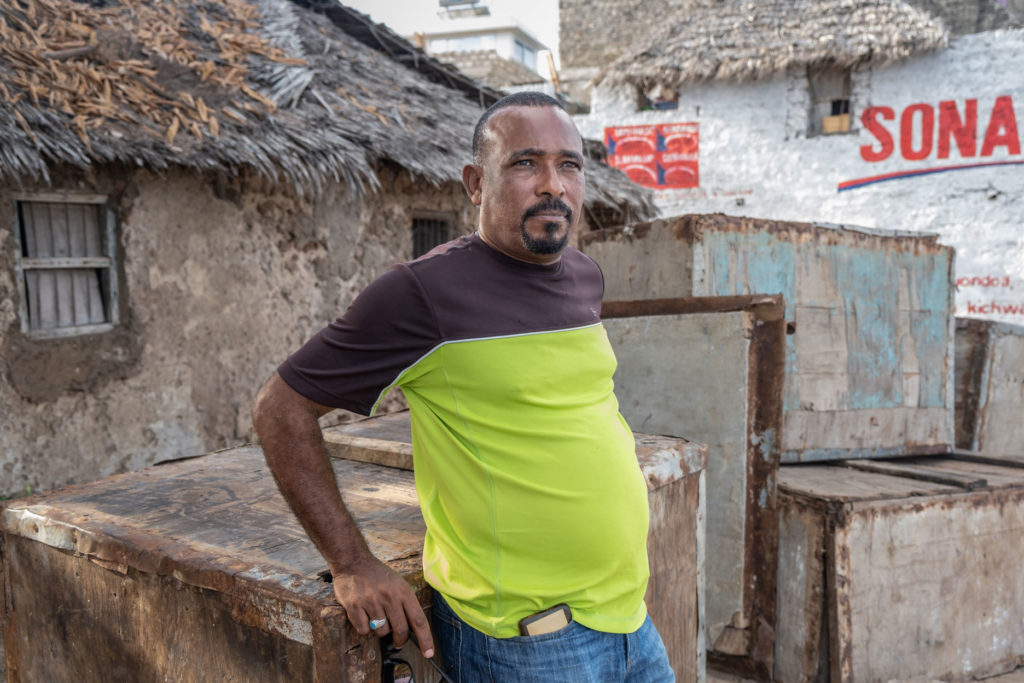
“We have to go and tell them we are fishing tonight, how many of us are going, how many days, and we have to write all of this down,” Athman tells me. “If they catch you even a day later than your permission, they will arrest you. They can accuse you of being a terrorist.”
As the fishermen’s livelihoods were slowly crushed, they began to increasingly view LAPSETT as a potential lifeline for much-needed income. “We wanted the port,” Athman concedes. “But in a good way — in a way that could help us access the jobs there.”
Preparations soon began, and Lamu’s fishermen unwittingly entered into what would become a prolonged nightmare.
An area near Manda Bay, where LAPSETT is being constructed, was one of the fishermen’s most vital fishing grounds. According to Mohammed, the fishermen have practiced rotational fishing for many generations, spending six months in the deep sea and then, during the rainy season, they switch to the shallow waters near Manda Bay, where it is safer.
But “No trespassing” signs were soon erected in the waters around the bay, while the Kenyan coast guard, which before had almost no presence in neglected Lamu, arrested any fishermen who attempted to enter the area.
Then, as the government broke ground on the port in 2012, dredging of the ocean floor began. The dredging, which removes sediments and debris from the bottom of shallow water bodies to ensure ports remain navigable, destroyed mangrove forests, seagrass and coral reefs in the surrounding marine nature reserves. According to locals, the dredging decimated fish and turtle populations, which used the coral reefs for nesting.
Now, “so many dhow riders are just sleeping,” Athman says, frustrated. “I have one week now that my dhow is just stuck there on the dock because there’s nowhere to go. Even crossing over there [to the nature reserve] to go snorkeling with the tourists can bring us a lot of problems with the coast guard.
“And even if we make it there, we can’t lie to the tourists,” he continues. “Because when you go there, you see nothing. It’s like looking through mud. Before, we could see so many kinds of colorful fish, lobster, and sea turtles. But now it’s all finished.”
Vae Bunu, 63, says he is grateful he has already grown old. “My father was a fisherman, and I started when I was very young,” he says, sitting in the BMU office on the outskirts of Lamu’s Old Town; several fishermen crowd inside to tell their stories. “No one in Lamu ever thought there would come a time when we were no longer able to fish in the sea.”
Before LAPSETT, Bunu says he was able to catch about 400 kilograms of fish per day. “But now in one week maybe you can catch 100 kilos,” he adds. “We’re not even making enough to pay for expenses.” The week prior, which was during the rainy season, Bunu says he purchased food, fuel and ice for 10,000 Kenyan shillings ($86) but made only 6,000 shillings ($52) for the week, putting him in the negative.
“But luckily I am old,” Bunu says, shrugging his shoulders. “The younger generations will have a much more difficult life than our generation because of this port. I’ve lived my life. I have children who I can depend on. Now I’m just waiting for when I go to my grave because there’s nowhere else to go from here. I never went to school. I’ve been fishing my whole life. So what else can I do at this point except wait for death?”
In 2018, the fishermen won a case for financial compensation, which they had filed through Save Lamu in 2012. Kenya’s High Court ordered the government to pay 1.76 billion shillings (more than $15 million) to 4,600 fishermen in Lamu County whose livelihoods were disrupted by LAPSETT. According to Mohammed, each fisherman expects to receive 241,000 shillings ($2,070), while the rest will go toward supporting other sections of the population indirectly dependent on fishing.
“This compensation is a robbery,” says 46-year-old Ali Bashali, a trader who provides fuel and ice for the fishermen and purchases their fish. Now, however, he rarely has the money to put in the initial investment. “They have bought me and all of our future generations for 241,000 Kenyan shillings. That’s how much it costs to steal our future. We now have nothing. They have already killed us.”
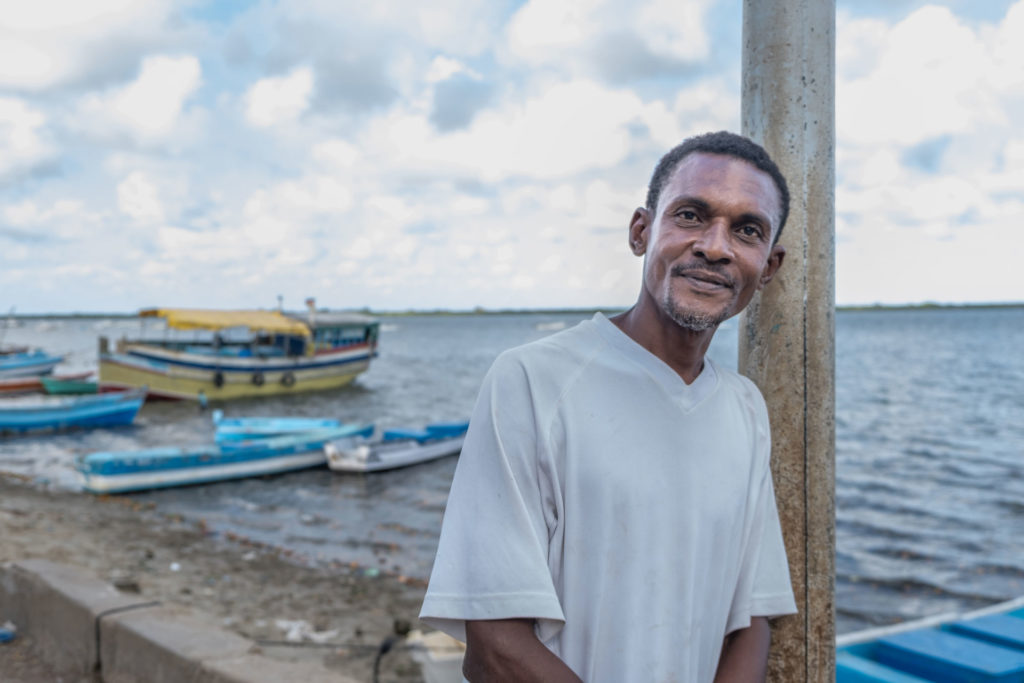
For the fishermen who have lost everything, however, this compensation is their only hope for survival. Yet four years later, they have still not received it. And times are becoming increasingly desperate. Many are racking up large amounts of debt, unable to afford their children’s school fees, rent or the rising costs of food.
If that was not enough, the fishermen tell me the Kenyan coast guard continually harasses them. As the government aims to regulate the seas around Lamu, the fishermen are being asked for licenses, certificates and boat registration forms — all of which cost money. Before the government’s interests in Lamu, the seas were “completely free,” without need for “papers.” They are now forced to pay frequent bribes to avoid being detained.
Meanwhile, “these fishermen know more about the sea than the Kenyan coast guard,” Mohammed says. “They don’t even know how to swim, and then they tell us we need to go back to school to learn to fish. If there’s ever a disaster, it will be the fishermen who will have to come and save the coast guard while they’re drowning.” The other men in the room begin chuckling, looking at each other and nodding in agreement.
The government also banned the use of monofilament nets, which Lamu’s fishermen had been using for decades, claiming they are environmentally unfriendly; the fishermen, however, deny this. Hundreds of fishermen have been arrested for continuing to use the banned nets because they cannot afford the alternative fishing gear, which they say is 10 times more expensive.
“They are just making all these decisions from an office in Nairobi,” Athman says. “It feels like it’s on purpose — like they are doing everything to intentionally torture and destroy us. Once we think it can’t get any worse, they will add another restriction that suffocates us even more.”
Despite claims that Lamu’s residents will be prioritized for the 200,000 jobs expected to come with LAPSETT’s opening, Mohammed says only about 100 people from Lamu County have so far been hired, and most at low-level positions. I reached out to LAPSETT director Mohammed Hashim numerous times for comment on these issues, but he did not respond. Locals, however, remain hopeful that once the development progresses, they will be able to access jobs.
But low education levels among the Bajuni in Lamu mean that many do not have the academic degrees required for higher-skilled employment at the port. This has aggravated feelings of being replaced by outsiders, as more Kenyans from the interior arrive to take up the better-paying jobs.
Athman, who has a wife and two young daughters, is at his breaking point. “I feel like I’m starting to go mad,” Athman says, resting his face in his palms. “And, imagine, I’m young. And I don’t know where to start. I don’t know what the future will hold for my children because life has become very hard.”
Athman has gone to school in Mombasa, costing him hundreds of dollars, to get certified to fish legally around Lamu. But surviving on fishing alone is no longer a viable option. “I want a job at the port because I need money so I can change how my life is going,” Athman says. “But without the paper [university degree], you can’t get anything at the port.
“Before I could get many jobs because everyone knows me, and they know I’m good at sea,” Athman continues. “But now the paper is talking. Without papers, you get nothing.”
Bashali, who is angrily strutting in and out of the office, furiously states: “Even if you had that paper, they wouldn’t hire you!” He turns to me and says: “The government will never, ever, ever hire someone like me or someone like [Athman]. Never! They will bring all their people from Nairobi and Kisumu. Even if we have every single thing needed to get a job at the port, they still won’t hire us.
“They want to replace us with their people from central Kenya. And then these people arrive at the airport and ask us: ‘Where’s Lamu?’ They come with their land titles. And then Kariuki [a Kikuyu name] will come to Lamu, and he won’t even know where his land is because he’s never seen it before.
“They want Lamu, but without the people of Lamu,” Bashali adds, waving his index finger back and forth, before slipping out of the office again. “They want to erase us.”
Bashali’s frustrations stem from a deep pain. As his livelihood collapsed, so too did his marriage. Festering stress from being unable to provide for his family reached its limit; he and his wife split, and his relationship with his children faltered.
“This government took everything from us,” Bashali says. “We’d have a better life if we traveled across the sea and landed in another country as refugees. Cats are treated better in other countries than this government treats us here.”
According to rights groups, gender-based violence among fishermen families is on the rise and drug addiction is becoming widespread. “Most of the people now are changing,” Athman says. “Some become crazy from the stress. My big brother, who was also a fisherman, went down that road. He just wanted a break from the stress, so he took a puff. Then he left his wife and kids. All he does now is look for drugs.”
Abu Bkar Mohammed Twalib, the chairperson of BMU, tells me he fears deeply for the future of Lamu. “There are no factories or businesses here, so in Lamu we’ve only ever had the sea,” the 49-year-old says. “The sea is the center of life in Lamu, so if you take the sea from us, we won’t have any other choice but to rob and kill.”
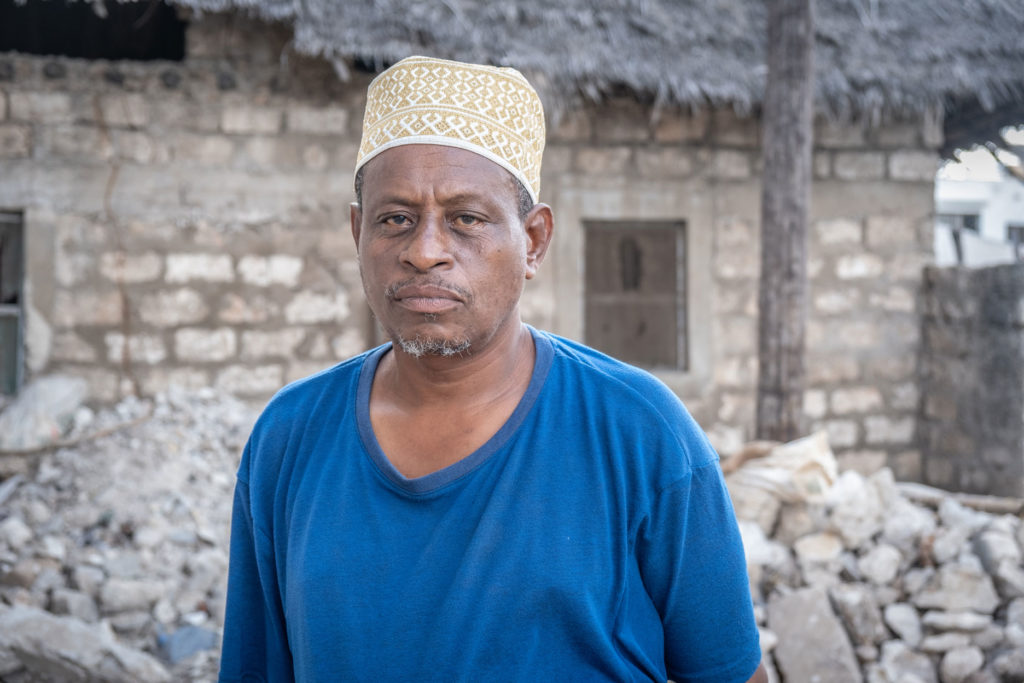
Lamu’s island economy and culture depends on residents’ free access to the sea, and as fishermen’s lives become increasingly strangled, there is a knock-on effect on the rest of the population.
Mama karanga, or women on the coast who buy and process fish for local markets from the small-scale fishermen, have also suffered. Khadija Mkutano, a mother of four children, sells fried fish on the streets of Lamu’s Old Town.
Mkutano, who has been selling fish for 15 years, says she used to buy 40 kilograms of fish, making a daily profit of at least 1,000 shillings (about $8). But now she can afford to purchase only 15 kilograms and sometimes she cannot sell all of it, owing to rising costs. She now makes about 300 shillings (about $2) per day.
“All of this hardship came because of that port,” the 35-year-old says, stooping over a pan of oil as she readies the fish to be fried in her small kitchen area. “This government said it would bring development. But my life is much worse now. They promised us heaven and then they delivered us hell. Lamu is going down and Nairobi is going up — that’s what development means for the people of Lamu.”
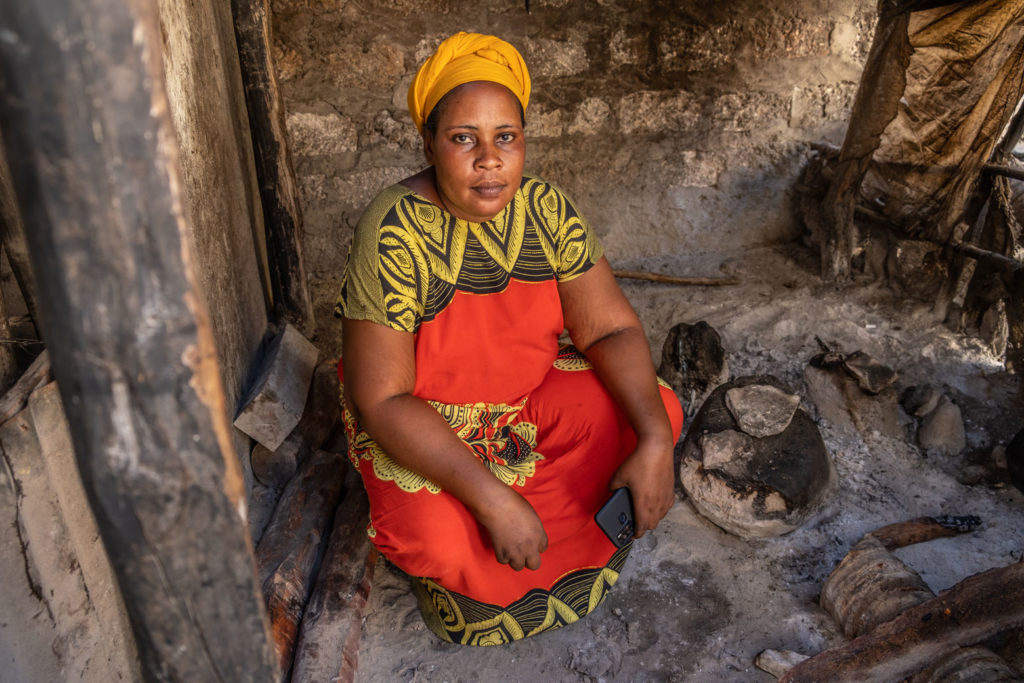
LAPSETT also threatens the culture of the island, residents say. Tourism plays an important role in the residents’ continued use of the dhow, but many fishermen have switched to using motorboats. And as tourism suffers, the demand for dhows has also waned, putting the intergenerational tradition of dhow-making in jeopardy.
“I learned how to build dhows from my father since I was a child,” says 45-year-old Faraji Mohammed Sadiq. “Everyone calls me ‘the dhow maker.’ I’m famous around here.” His face lights up in a proud, beaming smile.

“Before we were very happy,” he continues. “Here in Lamu, we used to say ‘Hakuna matata’ [There’s no worry]. People were happy with life. Usually, around this time, I would be taking the tourists on the dhow to go snorkeling. Then, we would spend two nights on Manda Toto Island. It’s a beautiful beach. We make coconut rice with a fish barbecue. The tourists are always very happy, and we made good money.”
Sadiq says that he has not constructed a new dhow for years. “I now mostly do repairs,” he says. “Before, we would take the clients and tourists all around the sea. But now we are restricted from using the sea so there’s no need to make more dhows.
“For now, I’m just waiting for that money [compensation] to come,” Sadiq adds. “We are patient and we have hope. Maybe one day they will call us and say the money is here. Maybe things will get better. I just don’t want to get old and be forced to beg on the streets. This is what worries me a lot — to get old and have nothing.”
In 2014, al-Shabab’s military unit Jaysh Ayman, whose members are mostly Kenyans, carried out its first attack. They targeted Mpeketoni, killing nearly 50 people, most of whom were Kikuyu.
In a statement, one of the justifications al-Shabab gave for the attack was that Mpeketoni was “originally a Muslim town before it was invaded and occupied by Christian settlers.” In response, President Uhuru Kenyatta ordered the repossession of 70% of the land titles issued in Lamu, mostly around the planned port, noting that 22 developers had irregularly acquired about 500,000 acres of public land.
Athman’s dhow, tied up to the island’s dock, drifts side to side as waves pass underneath. He throws a freshly caught octopus onto a portable gas stove and begins chopping onions, placing them into a frying pan. After a while, more and more people come to sit on the sides of the dhow — some of them fellow fishermen.
Athman begins serving the food, a mix of rice, vegetables and octopus, handing a plate to anyone who requests one. Everyone on Lamu Island has grown up together; they also share freely with one another — despite their deepening hardships. It is likely the only way these fishermen have survived up to now.
“The people of Lamu are sleeping,” Athman says, as he invites passersby to join the feast. “When they take out the fishermen, they will eventually take out everyone. People need to wake up before it’s too late.”
“This development is not for us,” he adds. “Even the nice roads they are constructing — none of it is for us. It is just a red carpet for people coming from Nairobi. This is all very sad for me. This is my island. But then they want us to leave so they can replace us with other people. We don’t even know if we will exist in the future.”



